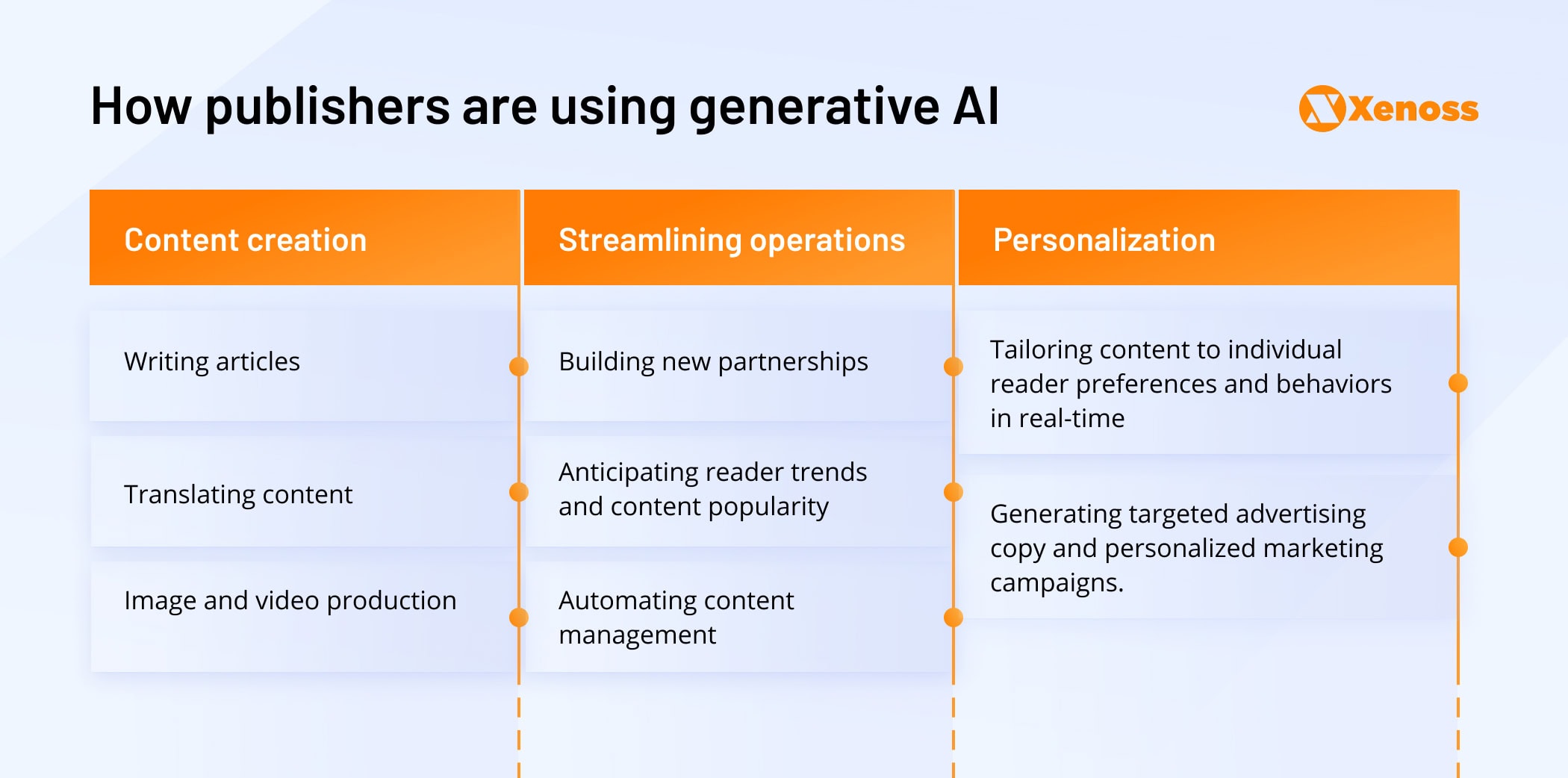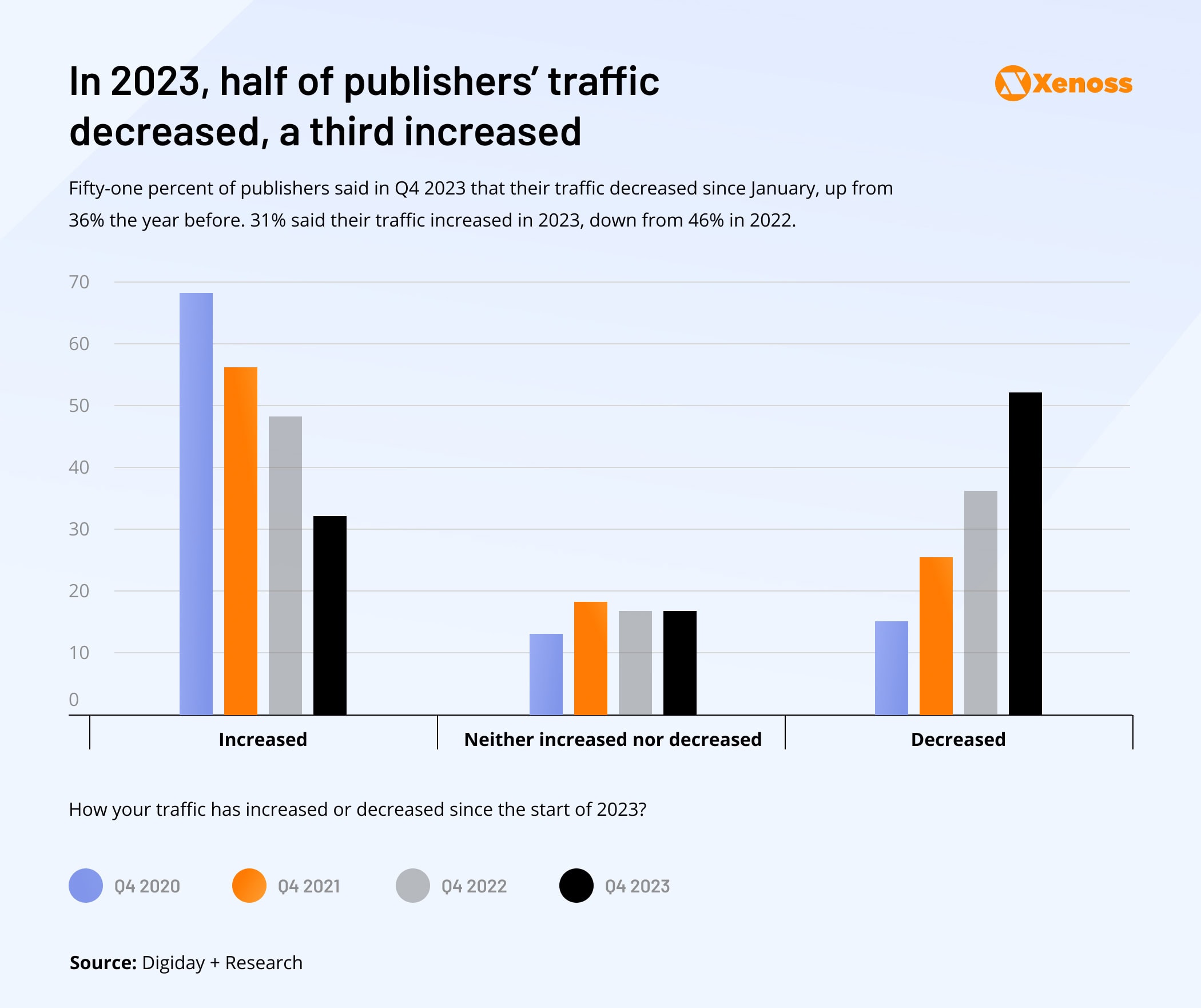As AI makes its way from a hardly accessible innovation to a universally available business tool through ChatGPT, Google Bard, and other tools, publishers are pushed to experiment with large language models and make conclusions about its use in content management and monetization.
Let’s look at how publishers applied generative AI thus far and their thoughts on it.
How publishers are using generative AI?
Although the first reaction to generative AI among publishers was skeptical, gradually, the media found ways to leverage large language models in writing, editing, and workflow automation.
Below, we summarize the key use cases for generative AI in media.

Having explored what AI can do, it’s time to give LLMs in media a report card and decide if the benefits they offer (time savings and operating cost reduction) outweigh the risks traditional media are facing due to generative AI (reputational damage and loss of readership to ChatGPT).
AI in writing gets the work done, but not it’s not done well
From an operational perspective, the promise of tools like ChatGPT to revolutionize the future of publishing is immense. In just a few seconds, it can churn out a piece of content that would be barely discernible from that of a human writer.
Understandably, large publishers did not want to miss out on the trend that could spell out the future of writing. Forbes, Insider, BuzzFeed, and others set up AI task forces to experiment with innovative tools. After months of testing, they realized that large language models still had a long way to go.
Nicholas Carlson, the editor-in-chief at Business Insider, spoke to Digiday about the rise of AI, underscoring that journalists need to be “very deliberate and cautious” about the ways in which they use these tools.
The skepticism journalists have towards generative AI in publishing stems from several scandals the use of these tools in newsrooms has generated so far. Back in January, CNET was among the pioneers of large language models in the newsroom – which erupted, to quote The Washington Post – in a “journalistic disaster.”
A similar controversy emerged when Gizmodo fired its Spanish editors in favor of gen AI-empowered Google Translate–only to discover that translations were often inaccurate, robotic, or reverted back to the original halfway through.
These cases show that publishers should first be fully aware of the challenges of generative AI adoption before they deploy it on a large scale and stake their reputation on its outputs.
AI in retail media helps sellers write product descriptions
Rather than expecting large language models to complete the job, Amazon decided to deploy generative AI to help sellers write product descriptions.
Since most brands put a lot of work into writing product descriptions, the ability to cut the effort down to writing a few words and letting AI technologies do the rest is compelling.
The outcome of the new practice is still to be determined, but the company believes it will be a win-win for sellers, who can save more time, and customers, who will get a more complete product knowledge.
Although Amazon’s update might be the most influential among retailers, it’s not the only AI product description experiment in the space. eBay also offers sellers a way to generate product descriptions from photos, and Shopify is testing a ChatGPT-like extension to support its merchants with AI-generated product descriptions.
Publishers use AI internally to shorten sales cycles
Besides deploying large language models as user-facing features, publishers increasingly rely on AI for internal communication. A while back, Jonah Peretti, Buzzfeed CEO, shared that generative AI was helpful in cutting the time needed to close crucial partner deals with Sprite, Serta, and Walmart.
The company also used AI to help advertisers match their proposals to BuzzFeed products: higher targeting precision led to deals closing weeks earlier than they normally would.
IAC also used generative AI to fuel its housekeeping operations: refining personalization, brainstorming content topics, and understanding their audiences’ preferences.
Some publishers see generative AI as a threat to their revenue and traffic
Reddit was the most widely discussed case of a company being vocal against tech companies using its enormous data corpus, provided every day by millions of users, to train LLM models, which will then be used to generate profit.
Other media share concerns about the negative effects of AI. Publishers speak up about their concerns that AI-generated content is cutting readership and leading to a slump in revenue.

According to Robert Thomson, Chief Executive at News Corp, “discussions are necessary” to establish “the issues and the obligations.” Thomson believes that tech companies should compensate publishers for the data they use to train models that produce AI-generated media and for the readership they divert by not mentioning their sources.
A similar train of thought is shared by Roger Lynch, chief executive at Conde Nast, and other media professionals.
At the same time, the situation might not be all doom and gloom for publishers: according to tech companies, the top goal is still to drive more traffic to media websites. According to Yusuf Mehdi, head of Bing at Microsoft, AI-powered-search is already doing that.
The takeaway
As the hype around generative AI slowly transforms into constructive discussions about using these tools to improve publishers’ relationships with readers and advertisers, both the promise and threats of LLMs become apparent.
For the most part, editors realize they are not ready to remove humans from content production, but AI can play a solid supporting role in tasks like personalization, targeting, or content idea generation.
As far as revenue and readership are concerned, the jury is still out. In the next several months, we will see whether improvements in new AI search, like quoting publishers featured by ChatGPT, balance the losses in traffic publishers may have experienced if their readers prefer talking to ChatGPT instead of reading their posts.